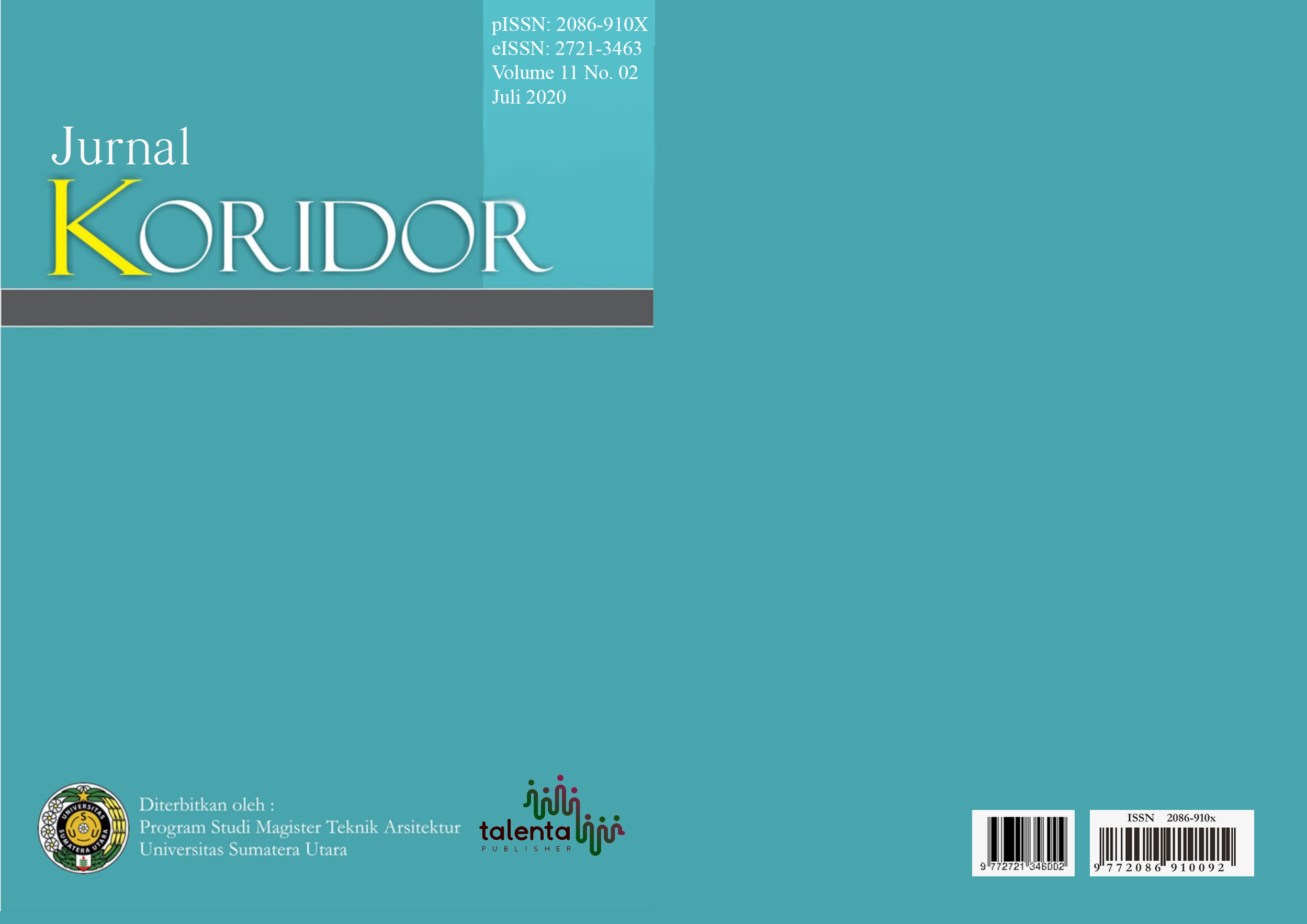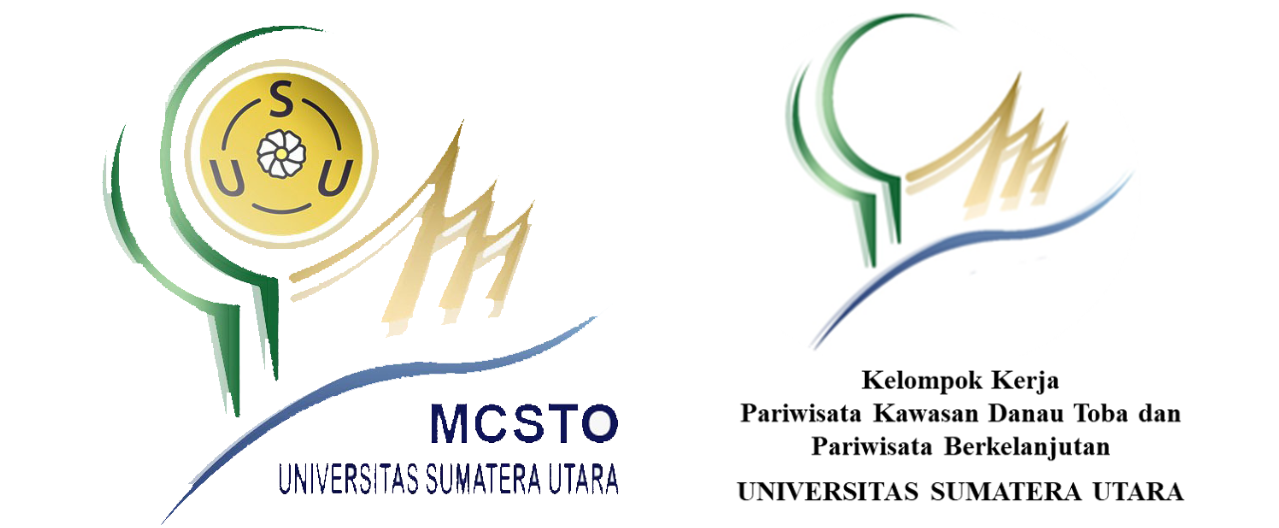Design of Culinary Tourism and Shopping Center in Tongging Village (Green Architecture)
DOI:
https://doi.org/10.32734/koridor.v11i02.4589Keywords:
tourism, Tongging, Cullinary tourism, Shopping, Green ArchitectureAbstract
Nowadays, eating and drinking is not only a basic need but also has become one of the tourist destinations. Tongging Village is one of the tourist villages with views of Lake Toba and its grilled fish that has the potential to develop culinary and shopping tourism. Besides, Tongging Village is also directed by the Indonesian Ministry of Tourism to become a culinary tourism and shopping center on Lake Toba. In designing a culinary tourism center and shopping, the application of green architecture is the right choice by utilizing natural resources and not damaging existing natural conditions. The design method was carried out qualitatively by a sequential systematic process and taking data through field surveys and interviews with the headman and local communities so that it produces points that could be used in designing. The design of culinary tourism and shopping centers with the application of green architecture aims to utilize natural resources without damaging natural conditions and attract tourist enthusiasm so that culinary and shopping tourism centers become one of the main tourist destinations for the Lake Toba Region which will affect the income of Indonesia's creative economy.
Keywords: Tourism, Tongging, Culinary Tourism, Shopping, Green Architecture
Downloads
References
Chi, Geng-Qing, Christina, Bee Lia Chua. Mohhidin Othman, and Shahrim Ab Karim. 2013. Investigating the Structural Relationships Between Food Image, Food Satisfaction, Culinary Quality, and Behavioral Intentions: The Case of Malaysia. International Journal of
Hospitality & Tourism, 14 (2), 99-120, DOI: 10.1080/15256480.2013.782215
Zahrulianingdyah, Atiek. 2018. Kuliner Sebagai Pendukung Industri Pariwisata Berbasis Kearifan Lkal. Teknobunga, 6(1). [Online].
Ginting, N., Rahman, N.V., Nasution, A.D. 2017. Increasing tourism in Karo District, Indonesia based on place identity. EnvironmentBehavior Proceedings Journal, 2(5). 177-184
Presiden Republik Indonesia. 2009. Undang-Undang No. 10 tahun 2009 tentang Kepariwisataan. Lembaran Negara Republik Indonesia tahun 2009 Nomor 11.
Jakarta: Sekretariat Negara.
Ginting, N. & Wahid, Julaihi. (2015). Exploring Identity’s Aspect of Continuity of Urban Heritage Tourism. Procedia Social and Behavioral Sciences, 202, 234-241
Rahayu Agustini. 2019. Siaran Pers : Menparekraf Sambut Baik Danau Toba Ditetapkan sebagai Unesco Global Geopark. [Online]. https://www.kemenparekraf.go.id/
post/siaran-pers-menparekrafsambut-baik-danau-tobaditetapkan-sebagai-unesco globalgeopark.
Guntur Sakti. 2019. Siaran Pers : Desa Tongging di Danau Toba Dikembangkan sebagai Destinasi Wisata Kuliner dan Belanja. [Online]. https://www.kemenparekraf.go.id/post/siaran-pers-desa-tongging-didanau-toba-dikembangkansebagai-destinasi-wisata kulinerdan-belanja.
Ingkadijaya. R, and friends. 2016. Aktivitas Wisata Pilihan Keluarga Perkotaan; Jurnal Khasanah Ilmu, 7 (1) 2087-0086. [Online]. https://ejournal.bsi.ac.id/ejurnal/in
dex.php/khasanah/article/download/459/352
International Council of Shopping Centers. 2017. (https://id.wikipedia.org/wiki/Inter national_Council_of_Shopping_Centers), diakses 28 April 2020
Presiden Republik Indonesia. 2007. Peraturan Presiden Republik Indonesia No. 112 tahun 2007 tentang Penataan dan Pembinaan Pasar Tradisional Pusat Perbelanjaan dan Toko Modern. Jakarta
Wikipedia. 2020. Pujasera. [Online]. https://id.wikipedia.org/wiki/Pujasera
Sari, Tutu, Gradia. 2017. Pusat Perbelanjaan Mall di Kabupaten Kubu Raya. Jurnal Online
Mahasiswa Arsitektur Universitas Tanjungpura, 5(2), 1-12. [Online]. https://media.neliti.com/media/publications/206163-pusatperbelanjaan-mall-di-kabupatenkub.pdf
Syoufa, Ade. Hapsari, Helen. 2014. Pengaruh Pola Sirkulasi Pusat Perbelanjaan Mall Terhadap Pola Penyebaran Pengunjung, Studi Kasus: Margocity, Depok. Jurnal Desain Konstruksi, 13(2), 46-57. [Online]. https://ejournal.gunadarma.ac.id/index.php/dekons/article/view/1135/995
Hanun, Meivirina. Murod, Chairul. 2014. Green Architecture and Energy Efficiency as a Trigger to Design Creativity: A Case Study to Palembang City Library. Journal of Architecture&Environment, 13(2), 123-140. [online]. http://iptek.its.ac.id/index.php/joae/art
icle/view/877/727
Fisamawati, Angraini, Gian, Putri Suryandari. 2019. Application of Green Architecture In The Design of Kohod Port Passenger and Water Tourism in Tanggerang Regency; Maestro Journal, 2 (2) 2655-3430. [Online]. jhttp://jom.ft.budiluhur.ac.id/index .php/maestro/aticle/view/224/92
Priatman, Jimmy. 2002. "EnergyEfficient Architecture" Paradigma dan Manifestasi Arsitektur Hijau. Journal of Architecture and Built Environment, 30(2) p. 170 2338-7858. [Online] http://dimensi.petra.ac.id/index.php/ars/article/view/15778/15770
Veronica, Selly. Ginting, N. Marisa, Amy. 2020. Local Wisdom-Based on Development of the Environment and Atmosphere Aspect of Berastagi Night Tourism. International Journal of
Architecture and Urbanism, 4(2), 144-155
Paramita., Purwatiasning. A.W., Satwikasari. A.F. 2019. Penerapan Konsep Arsitektur Hijau Pada Perencanaan Agrowisata Kopi di Temanggung. Jurnal Arsitektur PURWARUPA, 3(4) [Online] https://jurnal.umj.ac.id/index.php/purwarupa/article/download/3787/3702
Atikah. S, Bambang dan K, Rabbani. 2014. Penerapan Tema “Piring†dalam Perancangan Objek Wisata Kuliner. Jurnal Sains dan Seni Pomits, 3(2), 60-62. 2337-3520
Wikipedia. 2020. Grass block. [Online]. https://id.wikipedia.org/wiki/Grass_block
Wikipedia. 2020. Biopori. [Online]. https://id.wikipedia.org/wiki/Biopori












